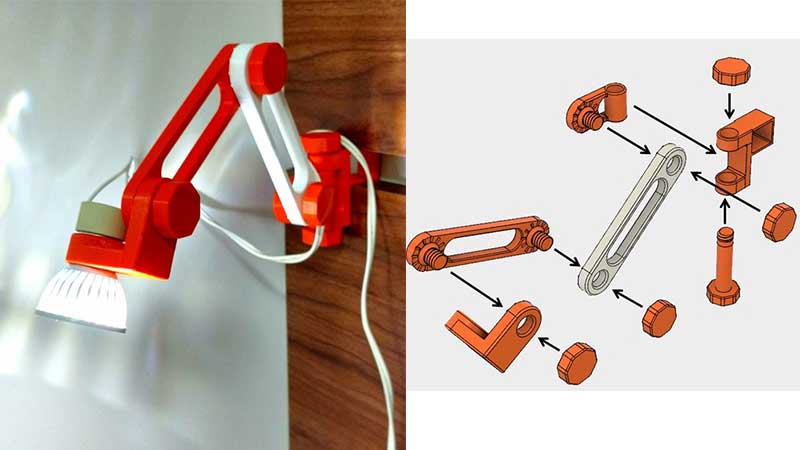The first print to come off a shiny new 3D printer is usually a toy widget of some sort that will forever sit at your desk without purpose. The alternative is a practical project that is custom and personal like this 3D Printed Articulating Lamp. [IgorF2] shares his design for this wall mounted device which was created using Fusion 360.
The complete design consists of eight parts which includes the arms, nuts, and bolts, as well as the wall mount, each of which can be printed individually. These come together to form a structure that can be attached to a wall or your work bench. Though [IgorF2] has provided arm pieces of length 100 mm, 140 mm and 200 mm, you can mix and match to create a much larger project. The files are available for download from Thingiverse for your making pleasure.
We think this can be a great basic structure for someone looking at custom wall mounted projects. The lamp mount can be easily supplemented by a Raspberry Pi and Camera holder if you feel like live streaming your bench. Alternatively, it may be customized to become a motion detecting lamp just for fun. We hope to see some good use come of it in the future.
















Nice first project, but could have surely made a better job of cable management. And perhaps add a small cowl so that the bulb is less naked?
thingiverse nicely allows for re-mixes — go for it!
that bulb is going to get mighty hot… can the plastic handle that?
An LED bulb is not getting that hot (and incandescents are outdated). The Thingiverse article states explicitly that it is for LEDs.
I do not quite understand the wall-mount. To me it looks like the mount is mostly constructed of two huge planks mounted on the wall and a piece of square plastic is jammed between it, hardly would call that a mount. Also the cable is simply forgotten in the design. Which is a pity as the concept by itself is very interesting. I really like the idea of the threaded parts embedded in the design, solving many small problems completely (for instance you can now assemble it much easier, even with one hand and without tools). Also the lamp itself looks clean and practical.
Fun project.
Yah, the instructable isn’t very illuminating about that design decision. It could be “this is only applicable to my bench and that slot was there.” or it could be a conscious attempt to make a rail that you could slide the lamp along at any point along the bench.
But yes, a shame it doesn’t have a conventional edge clamp for everyone else.
The two planks are the wall. It’s a style. Mid-mod, with a resurgence in the 1990’s/early 2000’s. Lived in a house with that style in the 1970’s, and worked in an office with the style (decor vintage 1960 +/-5 years) in the mid 80’s.
Most 3D printing plastics melt at around 200-250 °C.
The glass bulb of a general service incandescent lamp can reach temperatures between 200 and 260 °C, and halogen bulbs can reach up to 500 °C.
So yes, very glad the Thingiverse link specified that it should be an LED lamp. The article’s picture looked scarily like a halogen lamp at first glance.
Well pointed out, I almost mentioned it myself. Used 60W bulbs as a heatsource to form plastic items in past.
Only on first glance :-) If you look closer you see the heatsink-fins.
This would be great to mount my two oculus sensors to my TT Core X9 as a semi portable oculus rig.
That’s where beauty of this lies. In its ability to be used for different functions.
That style of wall was reasonable common in my neck of the woods a few years back.
Useing a mains LED globe is probably not a choice I would make. I would use a 12V globe and power supply but then, looking at his mains plug it’s only going to be around 110v which is relative low voltage ;-)
And it’s something useful to come of a 3D printer rather than another Yoda head ;-)
I see a mains plug only in the instructables-page and this is clearly a 230V plug. The link for the bulb also leads to a 220V to 240V only version. But he writes that you can use a 12V version, if you are unsure about working with mains voltage.